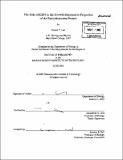| dc.contributor.advisor | Jacqueline A. Lees. | en_US |
| dc.contributor.author | Lee, Eunice Y. (Eunice Yoon) | en_US |
| dc.contributor.other | Massachusetts Institute of Technology. Dept. of Biology. | en_US |
| dc.date.accessioned | 2008-02-28T16:10:25Z | |
| dc.date.available | 2008-02-28T16:10:25Z | |
| dc.date.copyright | 2005 | en_US |
| dc.date.issued | 2005 | en_US |
| dc.identifier.uri | http://dspace.mit.edu/handle/1721.1/31180 | en_US |
| dc.identifier.uri | http://hdl.handle.net/1721.1/31180 | |
| dc.description | Thesis (Ph. D.)--Massachusetts Institute of Technology, Dept. of Biology, 2005. | en_US |
| dc.description | Includes bibliographical references. | en_US |
| dc.description.abstract | The growth suppressive functions of the retinoblastoma protein (pRB), the first identified tumor suppressor, are considerably mediated through the repression of the E2F transcription factors. Functional inactivation of pRB, and subsequent deregulation of E2F activity, is a critical event in the formation of most human cancers. pRB is a member of the pocket protein family, which includes p107 and p130. The pocket proteins have some functional redundancy; however, they have differential binding properties to the E2Fs and make very different contributions to the suppression of tumors. The E2F proteins that associate with the pocket proteins can be divided into two groups based on structural and functional similarities. The activating E2Fs, E2F1, E2F2 and E2F3a, are exclusively regulated by pRB and are primarily involved in activating the transcription of E2F-responsive genes that are required for cell cycle progression. The repressive E2Fs, E2F3b, E2F4 and E2F5, are regulated by the entire pocket protein family and are important for transcriptional repression. Mechanistically, the inappropriate proliferation promoted by the absence of pRB is, in large part, attributed to the activating E2Fs. This study investigates the contribution of a repressive E2F, E2F4, to the growth inhibitory properties of pRB during normal development and tumorigenesis. The characterization of mutant mice demonstrated that E2F4 loss significantly suppresses tumor formation in the Rb+/- animals. Molecular analyses suggest a novel mechanism in which p107 and p130 compensate for the loss of pRB by re-establishing the proper regulation of the activating E2Fs. The function of E2F4 in the developmental phenotypes arising from homozygous mutation of Rb was also assessed. | en_US |
| dc.description.abstract | (cont.) In contrast to the tumor setting, E2F4 loss aggravated the placental defect in the Rb-/- mice, resulting in earlier lethality. Furthermore, there was no cooperation between E2F4 and pRB within the developing embryo. These results indicate that E2F4 acts in a manner differing from the activating E2Fs in mediating the effects of pRB deficiency in development. Thus, this study has established that E2F4 is a key downstream effector of pRB and has reshaped our understanding of the roles of the activating and repressive E2Fs with respect to the pocket proteins. | en_US |
| dc.description.statementofresponsibility | by Eunice Y. Lee. | en_US |
| dc.format.extent | 235 leaves | en_US |
| dc.language.iso | eng | en_US |
| dc.publisher | Massachusetts Institute of Technology | en_US |
| dc.rights | M.I.T. theses are protected by copyright. They may be viewed from this source for any purpose, but reproduction or distribution in any format is prohibited without written permission. See provided URL for inquiries about permission. | en_US |
| dc.rights.uri | http://dspace.mit.edu/handle/1721.1/31180 | en_US |
| dc.rights.uri | http://dspace.mit.edu/handle/1721.1/7582 | |
| dc.subject | Biology. | en_US |
| dc.title | The role of E2F4 in the growth suppressive properties of the retinoblastoma protein | en_US |
| dc.type | Thesis | en_US |
| dc.description.degree | Ph.D. | en_US |
| dc.contributor.department | Massachusetts Institute of Technology. Department of Biology | |
| dc.identifier.oclc | 61267131 | en_US |
